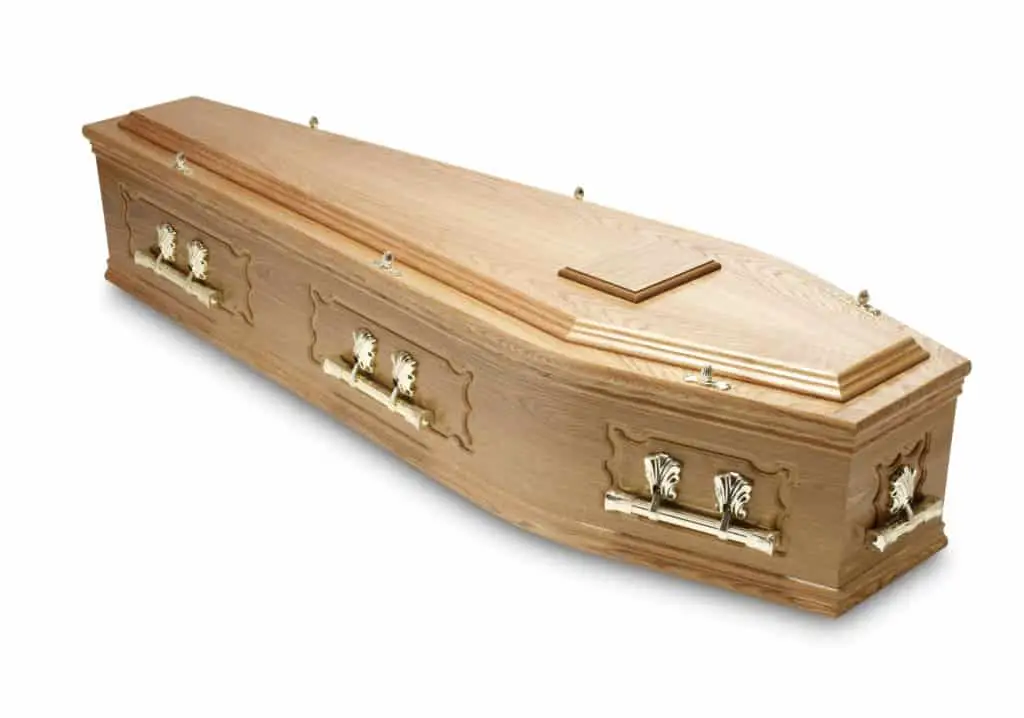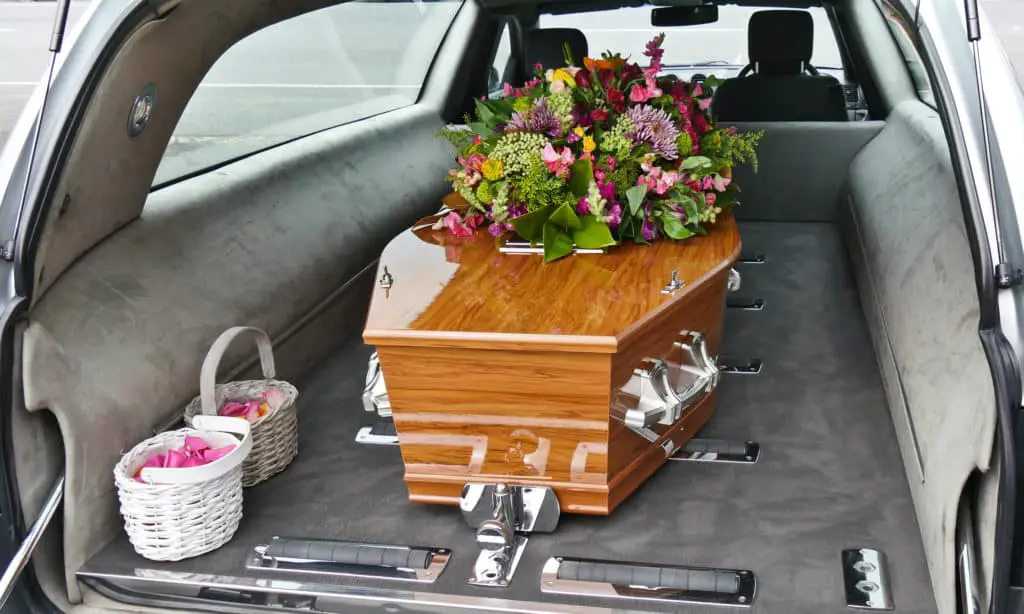There are a lot of decisions to make when a loved one passes away, particularly when it comes to the funeral. According to the National Funeral Directors Association, funerals cost approximately $7,848, so you shouldn’t take these decisions lightly. If you choose to bury your loved one, you will need to decide on a coffin or a casket for the deceased.
Coffins have been used for thousands of years, are made of wood, and typically consist of six sides tapered to the body. Caskets are an American tradition, and they are rectangular vessels made of wood and metal. Caskets are more ornate than coffins, leading to a higher cost and heavier weight.
In this article, I will detail the differences between coffins and caskets listed above and more. I will also talk about the pros and cons of each and some alternative burial containers growing in popularity in recent years.
Differences Between Coffins and Caskets
Though the terms “coffin” and “casket” are often used interchangeably, there are several differences between the two. Here is a summary table of all the main differences we are going to discuss in this article:
| Coffin | Casket | |
| Origins | Eastern world | United States |
| Shape / Number of sides | Hexagonal, six sides Tapered to the body | Rectangular, four sides Not tapered to the body |
| Lids / Hinges | One lid Not hinged | Split lid Hinged |
| Handles | Individual handles | Bar handles |
| Materials used | Wood | Wood, Metal, Decorated cloth |


Origins
The first difference between coffins and caskets is where they originate from and how long we have been using them.
Coffins have been used for thousands of years. In fact, the oldest coffin, found in Beishouling, Shaanxi, dates back to 5000 BCE. These burial containers are still prevalent in much of the world, particularly in the UK and other parts of Europe.
On the other hand, caskets are the Americanized version of the coffin. Although coffins were popular in the North American Colonies until the middle of the 19th century, the casket started gaining popularity in America during the Civil War.
Today, most burial containers used in the United States are caskets.
Shape and Number of Sides
The most notable difference between coffins and caskets is their shape and number of sides.
Coffins typically have six sides, though they can have up to eight.
The coffin shape resembles the natural shape of the body. It is wider at the shoulders and then becomes narrower at the feet. Coffins are traditionally custom-made to the exact specifications of the deceased’s body so that their shoulders fit perfectly in the broadest part of the coffin.
This hexagonal or octagonal shape saves wood and space, making it an efficient vessel.
The casket, however, is rectangular with only four sides. The casket is not tapered to the body and is more box-shaped. This style hides the shape and size of the body since caskets typically come in a standard size that fits most adults.
Lid and Hinges
Along with the shape of the coffin or casket, the lid and hinge types are also different.
Coffins typically have a solid cover consisting of one piece of wood. This lid can be removed from the body of the coffin and generally is not hinged. Nails are usually driven into the wood to keep it shut permanently.
In contrast, the lid of a casket is typically two parts hinged to the casket’s body.
The first part covers the top half of the body, while the second part covers the bottom half. This style of the lid is popular for funerals with a viewing. The hinged split lid allows the body to be partially covered, only revealing the top half during the service.
Handles
Along with the shape and type of cover, the handles on coffins and caskets are also quite different.
Coffins tend to have individual handles at various points along the body of the coffin. These handles allow the pallbearers to carry the coffin to the grave for the burial.
Caskets are different in that they often have long bars on each of the four sides of the casket. These bars go along the vessel’s length and allow for more pallbearers than a typical coffin.
Materials Used
The materials used in each instance are different as well.
Coffins are more traditional than caskets and consist primarily of wood. The boards used in coffins are usually thin, making it easier for the vessel to degrade. The most common materials for coffins are:
- Oak
- Pine
- Mahogany
- Bamboo
- Wicker
- Cardboard
Caskets are usually more adorned than coffins. Since it is popular to use caskets during viewings, the casket is often more ornate and consists of durable materials.
The most common materials for caskets are:
- High-cost wood: Mahogany, Walnut, Cherry
- Medium-cost wood: Oak, Birch, Maple
- Low-cost wood: Pine, Poplar, Willow
- Metal: Standard steel, stainless steel, copper, bronze
Additionally, caskets may also have plush inner linings and gaskets. The inner lining, made out of cloth and fiberboard, emulates comfort and looks nice for those attending the service. It is also common to add rubber gaskets to the casket to seal it with a protective layer and keep out the elements.

The Pros and Cons of Coffins and Caskets
Choosing between a coffin and a casket for your loved one can be a big decision. Here are a few pros and cons of each choice to consider before purchasing a coffin or a casket:
Pros of a Coffin
- Simple design. One pro of a coffin is the simple design. Since coffins are not as ornate as the casket and are tailored to the deceased’s body, the primary choice you’ll need to make when selecting a coffin is the type of wood you will use.
- Cost of material. Coffins often consist of one type of wood, so the cost of the materials can be less than caskets which have more ornate designs. Additionally, since the coffin tapers at the shoulders and feet, there is less material used when building the coffin. Using less material again drives down the cost.
- Traditional. Coffins are very conventional and have been used for thousands of years worldwide. Some people and religions value the ancestral origins of the coffin and therefore may see that as a pro.
Cons of a Coffin
- Cost of handiwork. Though the material price may be lower, the handiwork to construct the coffin may be more expensive. Because you must craft the coffin shape and size to the body, more work is involved in designing the coffin than a traditional rectangular casket.
- It may not fit every body type. Coffins hold a conventional shape and are broader at the shoulders and narrow at the feet. People who do not have that general body shape may not fit well in a traditional coffin.
Pros of a Casket
- Suitable for viewings. Because the casket is built with a hinged lid and is typically decorated, the casket is a great choice when there will be a viewing of the body.
- More room for pallbearers. Another pro of choosing a casket is that there is more room for pallbearers, thanks to the long bars on each side of the casket. These bars allow more people to carry the deceased, further distributing the weight and lessening the load on each pallbearer.
- Protective against the elements. Since caskets are typically sealed or made from durable materials, the body is better protected from the elements. This extra layer of protection can ultimately slow the decomposition process.
- Customizable. Caskets are made as showpieces and are therefore highly customizable. You can get the exact design that you want when purchasing a casket. You get to choose the different materials used, the designs on the body of the casket, and the colors.
Cons of a Casket
- Cost of customization and materials. Though caskets are highly customizable, the different options come at a cost. Since casket designs use multiple materials, it is common for ornate caskets to cost more than simple coffins.
- Weight. All the extra material also adds to the weight of the casket. If you choose a heavier wood and add other customizations, the casket can weigh several hundred pounds.
Eco-Friendly Coffin and Casket Alternatives
Though coffins and caskets have long been traditional, a new type of container is gaining popularity: eco-friendly burial containers.
It is not surprising that conventional coffins and caskets can harm the environment during conventional burials.
The chemicals traditionally used to preserve the body leak into the ground, contaminating the soil and groundwater. It is also common to use chemicals when building coffins and caskets to protect the structure further and preserve the body inside.
Both coffins and caskets take up a lot of space, and as more and more people pass away, cemeteries struggle to keep up with the demands for plots and the upkeep of the grounds.
Eco-friendly burial containers are made from sustainable and renewable materials and have a smaller carbon footprint than traditional coffins and caskets.
Additionally, eco-friendly burial options are typically cheaper than traditional burial containers.
If you are interested in exploring some coffin and casket alternatives, here are a few options you can look into:
Cardboard Coffin
The cardboard coffin is made from recycled materials and doesn’t contain metals or toxins. These coffins are 100% biodegradable, are compostable, and are cheaper than traditional coffins at just a few hundred dollars. You can read more about coffin prices here on my site.
The other great thing about cardboard coffins is that you can customize them by drawing directly on the coffin. This burial container can feel more personal as the whole family can be involved in the process.
To learn more about cardboard coffins, you can watch this YouTube video from Mourning Dove Studio:
Woven Fiber Casket
If you like something a little more ornate than a cardboard coffin, a woven fiber casket may be a good choice for you. These caskets are made from renewable materials woven together to create a pretty, basket-like design. Materials that you may see in this design include:
- Bamboo
- Willow
- Seagrass
- Cotton
- Banana leaf
- Rattan
These caskets weigh up to 50 pounds (22.67 kg) and can be made in various shapes and sizes to fit the deceased. Woven caskets typically cost more than cardboard coffins and range from $950 to $2,800.
Natural Wood Casket
For those who prefer the traditional look of a casket but want a greener option, a natural wood casket could be an excellent option. These are made from sustainable wood, such as pine, and contain no metal nails, screws, or handles.
Natural wood coffins are not sealed with chemicals or other materials and can use methods such as dovetail joinery to avoid the use of metal nails and screws.
Additionally, you can use biodegradable ropes in place of metal handles.
To see an example of a fully wooden coffin, check out this YouTube video from Casket Plans:
Mushroom Coffin
If you want something completely natural, you can check out the mushroom coffin. These coffins eliminate the need for wood and metal and consist entirely of organic materials.
Fungus spores are mixed with natural sawdust to make these coffins. Then, the paste is formed into a coffin shape that grows into a light and sturdy material that feels similar to Styrofoam or particleboard.
The makers then line the coffin with moss, and the body is placed inside without any synthetic materials or embalming chemicals.
The mushrooms in this coffin feed on the decaying body and break down the toxins it would otherwise release into the environment. This burial method effectively turns the body into compost, nourishing the soil and leaving behind no trace of a burial container.
While these natural coffins can be expensive compared to other eco-friendly options at roughly $1,800, they are still cheaper than most traditional coffins and caskets.
To learn more about mushrooms coffins, check out this YouTube video from Business Insider:
Final Thoughts
Coffins are traditional burial containers made from wood. They are hexagonal, tapered to the body, and have a single, unhinged lid. In addition, coffins are not ornate and are usually simple in design.
Caskets are the Americanized version of the coffin. They consist of multiple materials, including wood, metal, and cloth. They are typically showpieces for viewings and have a two-part hinged lid to reveal the top part of the body and are ornate in design.
Sources
- Heart and Soul Funerals: Safety guidelines for bearing and lowering a coffin
- National Funeral Directors Association: Statistics
- Federal Trade Commission: Funeral Costs and Pricing Checklist
- Coffin Works: From Coffins to Caskets – An American History
- Funeral Basics: How to Select a Casket
- Casket and Funeral Supply Association of America: Casket Design
- Carolina Memorial Sanctuary: Biodegradable Burial Containers for Green Burial – Coffins and Caskets
- YouTube: Mourning Dove Studio
- Carolina Memorial Sanctuary: Biodegradable Burial Containers for Green Burial – The What & Why + Shrouds
- Carolina Memorial Sanctuary: Biodegradable Burial Containers for Green Burial – Strange and Unusual
- AgeCo: What is a Coffin Made Of?
- Wikipedia: Coffin
- Smithsonian Magazine: Could the Funeral of the Future Help Heal the Environment?
- Journal of Anatomy: Human body preservation – old and new techniques
- YouTube: Business Insider – Mushroom Coffins Turn Bodies Into Compost And Make Death Less Toxic | World Wide Waste
- YouTube: Casket Plans – Eco-friendly Casket Kits
